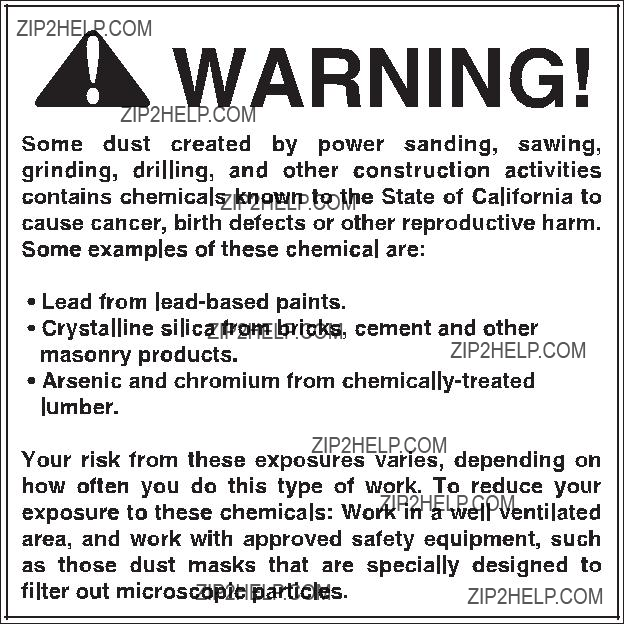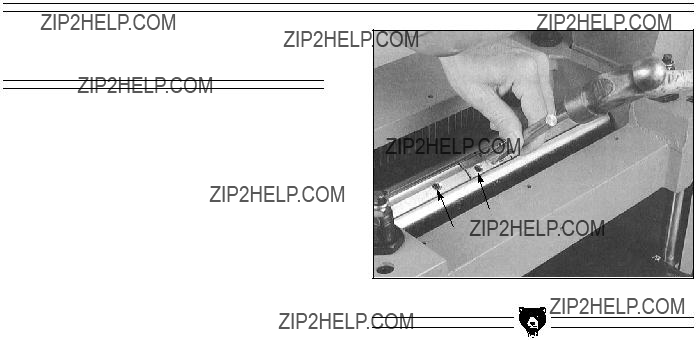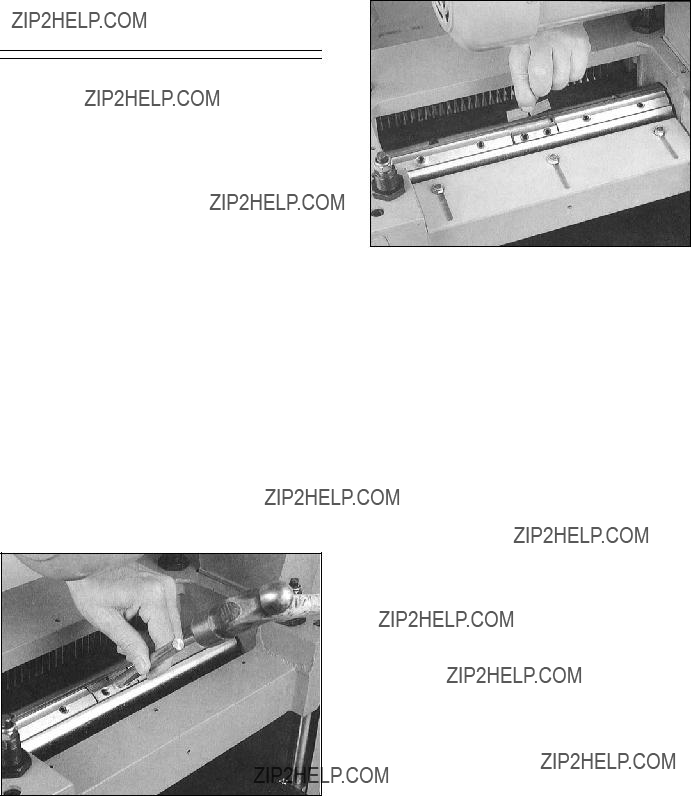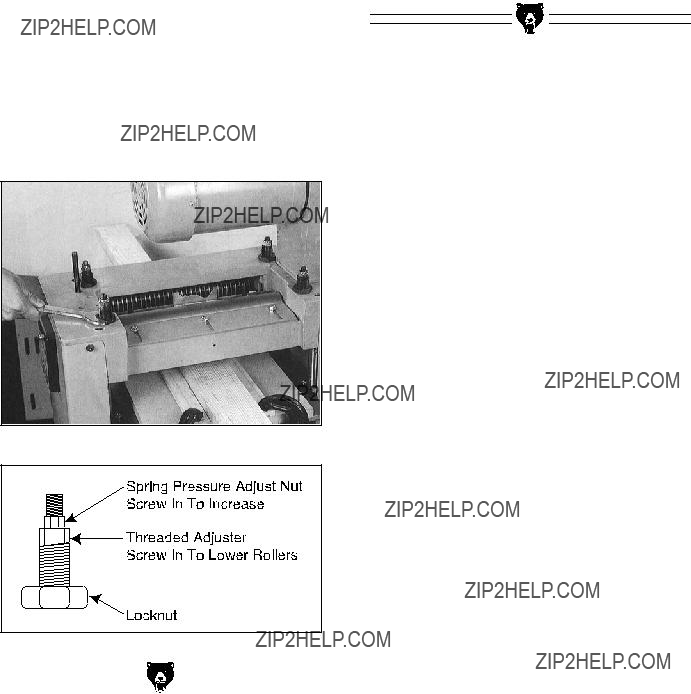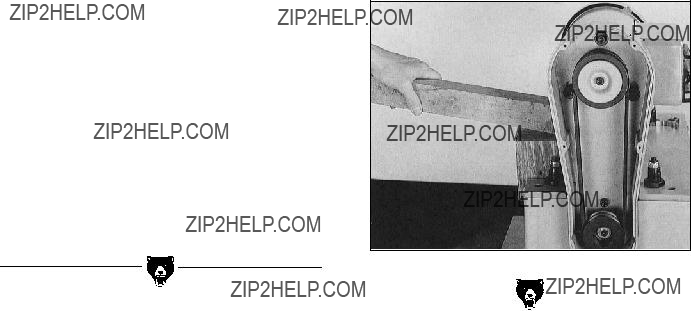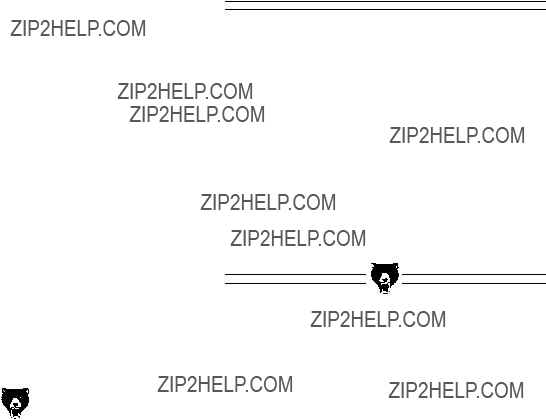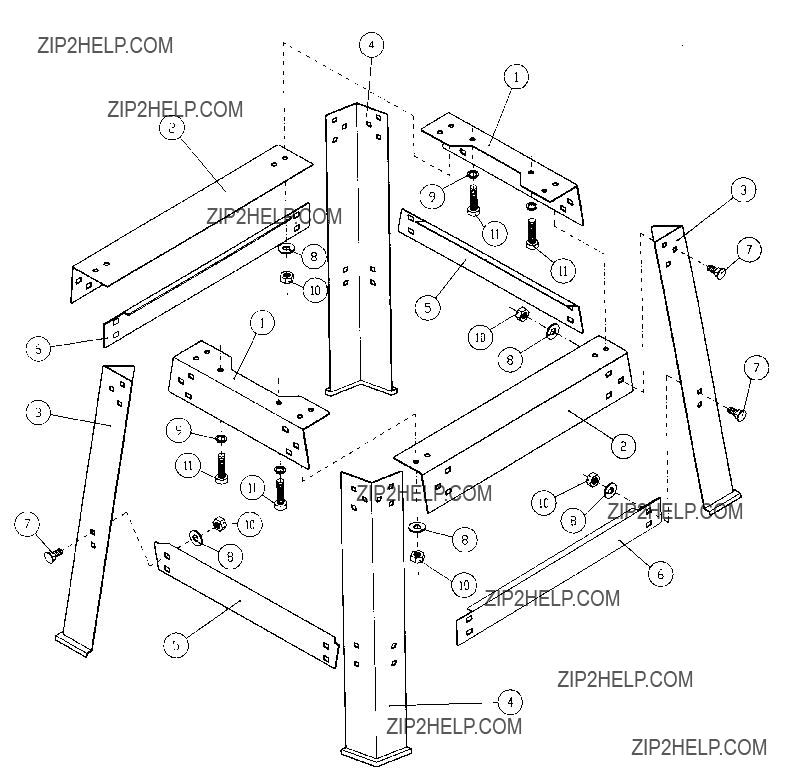13'' PLANER MOULDER
MODEL G1037
INSTRUCTION MANUAL
COPYRIGHT ?? 1996 BY GRIZZLY INDUSTRIAL, INC.
WARNING: NO PORTION OF THIS MANUAL MAY BE REPRODUCED IN ANY SHAPE
OR FORM WITHOUT THE WRITTEN APPROVAL OF GRIZZLY INDUSTRIAL, INC.
SEPTEMBER, 1997 PRINTED IN TAIWAN
SECTION 1: SAFETY
WARNING: For Your Own Safety Read Instruction Manual Before Operating Planer-Moulder
a)Always wear eye protection.
b)Be sure all guards are in place before oper- ating equipment.
c)Read the operators manual thoroughly and familiarize yourself with the machine before attempting to operate.
d)Support the workpiece adequately at all times during operation; maintain control of the work at all times.
e)Do not attempt to perform an abnormal or little-used operation without study and the use of adequate hold-downs, jigs, fixtures, stops, and the like.
Safety Instructions For Power Tools
These safety rules cannot cover every situation in a workshop. Consider your conditions when setting up or operating your planer-moulder.
1.KEEP GUARDS IN PLACE and in working order.
2.REMOVE ADJUSTING KEYS AND WRENCHES. Form habit of checking to see that keys and adjusting wrenches are removed from tool before turning on.
3.KEEP WORK AREA CLEAN. Cluttered areas and benches invite accidents.
4.DON???T USE IN DANGEROUS ENVIRON- MENT. Don???t use power tools in damp or wet locations, or expose them to rain. Keep work area well lighted.
5.KEEP CHILDREN AWAY. All visitors should be kept a safe distance from work area.
6.MAKE WORK SHOP KID PROOF with padlocks, master switches, or by removing starter keys.
7.DON???T FORCE TOOL. It will do the job bet- ter and safer at the rate for which it was designed.
8.USE RIGHT TOOL. Don???t force tool or attachment to do a job for which it was not designed.
-2-
9.USE PROPER EXTENSION CORD. Make sure your extension cord is in good condition. When using an extension cord, be sure it is rated Hard Service (grade S) or better. Conductor size must be 14 A.W.G. for cords up to 50 feet in length. An undersized cord will cause a drop in line voltage resulting in loss of power and overheating. Your exten- sion cord must also contain a ground wire and plug pin. Always repair or replace exten- sion cords if they become damaged.
10.WEAR PROPER APPAREL Do not wear loose clothing, gloves, neckties, rings, bracelets, or other jewelry which may get caught in moving parts. Nonslip footwear is recommended. Wear protective hair covering to contain long hair.
11.ALWAYS USE SAFETY GLASSES. Also use face or dust mask if cutting operation is dusty. Everyday eyeglasses only have impact resistant lenses, they are NOT safety glasses.
12.SECURE WORK. Use clamps or a vise to hold work when practical. It???s safer than using your hand and frees both hands to operate tool.
G1037 Planer / Moulder
13.DON???T OVERREACH. Keep proper footing and balance at all times.
14.MAINTAIN TOOLS WITH CARE. Keep tools sharp and clean for best and safest perfor- mance. Follow instructions for lubricating and changing accessories.
15.DISCONNECT TOOLS before servicing and changing accessories, such as blades, bits, cutters, and the like.
16.REDUCE THE RISK OF UNINTENTIONAL STARTING. Make sure switch is in off posi- tion before plugging in.
17.USE RECOMMENDED ACCESSORIES.
Consult the owner???s manual for recommend- ed accessories. The use of improper acces- sories may cause risk of injury to persons.
18.CHECK DAMAGED PARTS. Before further use of the tool, a guard or other part that is damaged should be carefully checked to determine that it will operate properly and perform its intended function - check for align- ment of moving parts, binding of moving parts, breakage of parts, mounting, and any other conditions that may affect its operation. A guard or other part that is damaged should be properly repaired or replaced.
19.DIRECTION OF FEED. Feed work into a blade or cutter against the direction of rota- tion of the blade or cutter only.
20.NEVER LEAVE TOOL RUNNING UNAT- TENDED. TURN POWER OFF. Don???t leave tool until it comes to a complete stop.
Additional Safety Instructions For Planer-Moulders
1.Inspect your stock carefully before you feed it through the machine. If you have any doubts about the stability or structural integrity of your stock, DO NOT USE IT!
2.NEVER mill stock that has loose knots. All defects should be cut out of the board before it is processed.
3.NEVER plane a board less than 14" in length.
4.Before starting up, recheck to make certain all screws are tight.
5.Never plane more than 3???16" in one pass except in the first moulding pass where you must bring up the table until the rollers con- tact the board.
6.Do not force-feed your work through the machine. Allow the planer to apply the prop- er feed rate.
7.Use sound lumber with no loose knots and with as few tight knots as possible.
8.The hood should always be DOWN and cov- ering the cutterhead when the motor is on.
9.Do not stand directly in front of or in back of the workpiece as it is feeding through your power tool. Stand to one side.
10.After a long period of operation, stop the machine, disconnect the power, and check the cutterhead gibs and screws for tightness.
11.Habits ??? good and bad ??? are hard to break. Develop good habits in your shop and safe- ty will become second-nature to you.
12.Check the feed roller bearings occasionally to be sure chips are not lodged between bearings and the side plate. If bearings are not seated firmly, the feed rollers will not hold stock firmly against the bed, and kickback will occur.
13.Never stand directly in line with either the infeed or outfeed side. Always stand to one side of the machine. With any power tool, kickback is always a possibility.
SECTION 2: CIRCUIT REQUIREMENTS
The motor supplied with the G1037 is a dual volt- age motor, prewired for 110V. Under normal use, the motor draws approximately 17 amps @ 110V, 8.5 @ 220V. We recommend using a 20 amp cir- cuit breaker or a 30 amp slow blow fuse for 110V or 220V operation. This should be satisfactory for normal use, while preventing motor damage from high heat caused by overload. If frequent circuit failures occur when using the planer/moulder, contact our service department or your local elec- trical contractor.
An instruction sheet has been included for rewiring for 220V. If this sheet is missing, call the appropriate service center for more information. Do not attempt to rewire without the instruction sheet.
Figure 1. Recommended 220V receptacle.
SECTION 3: GENERAL INFORMATION
Grizzly Industrial, Inc. is proud to offer the Model G1037 Planer/Moulder. This Planer/Moulder is a part of Grizzly???s growing family of fine woodwork- ing and metalworking machinery. When used according to the guidelines stated in this manual, you can expect years of trouble-free, enjoyable operation.
The Model G1037 is intended for home and medi- um-duty professional use. This Planer/Moulder features a 1,725 R.P.M., 11???2 H.P. capacitor-start motor, mechanical ON/OFF switch and a cast iron table.
All running parts utilize shielded ball bearings, which require no lubrication for the life of the bearings.
We are also pleased to provide this manual with the Model G1037. It was written to guide you through assembly, review safety considerations, and cover general operating procedures. It repre- sents our latest effort to produce the best docu- mentation possible. If you have any criticisms that you feel we should address in our next printing, please write to us at the Bellingham, WA address at the end of this section.
Most important, we stand behind our machines. We have two excellent regional service depart- ments at your disposal should the need arise. If you have any service questions or parts requests, please call or write to us at the location listed below.
Grizzly Industrial, Inc.
1203 Lycoming Mall Circle
Muncy, PA 17756
Phone:(570) 546-9663
Fax:(800) 438-5901 E-Mail: techsupport@grizzly.com Web Site: http://www.grizzly.com
To comment on this manual write to:
Grizzly Industrial, Inc.
C???O Technical Documentation
P.O. Box 2069
Bellingham, WA 98227
To operate this or any power tool safely and effi- ciently, it is essential to become as familiar with it as possible. The time you invest before you begin to use your Model G1037 will be time well spent. DO NOT operate this machine until you are com- pletely familiar with the contents of this manual.
Mounting To Stand
Set the Planer/Moulder onto the assembled stand and bolt together with the four M8-1.25 x 50mm Cap Screws. Of course, you will need assistance to do this step. Do not attempt to do this alone.
Figure 6. Mounting to stand.
Figure 5. Assembled stand.
SECTION 5: ADJUSTMENTS
Knife Removal
Unplug your Planer/Moulder from its power source.
WARNING: Always unplug your planer from its power source before changing knives and mould- ing cutters.
1. Simply loosen the gib setscrews and tap the gib down using a hammer and the included brass punch or a piece of wood. Figure 7.
2.Once the gib is free, remove the knife first and then the gib.
3.Mark the gib and matching slot to be sure that the gib is replaced in its original position.
4.Clean the knife and cutterhead slot to remove all pitch and gum residue.
5.Repeat this procedure for the other two knives.
Specifications, while deemed accurate, are subject to change without notice.
TROUBLESHOOTING
WARNING: For your own safety, turn the switch off and disconnect power source before troubleshooting.
TROUBLESHOOTING
WARNING: For your own safety, turn the switch off and disconnect power source before troubleshooting.

WARRANTY AND RETURNS
Grizzly Industrial, Inc. warrants every product it sells for a period of 1 year to the original purchaser from the date of purchase. This warranty does not apply to defects due directly or indirectly to misuse, abuse, negligence, accidents, repairs or alterations or lack of maintenance. This is Grizzly???s sole written warranty and any and all warranties that may be implied by law, including any merchantability or fitness, for any par- ticular purpose, are hereby limited to the duration of this written warranty. We do not warrant or represent that the merchandise complies with the provisions of any law or acts unless the manufacturer so warrants. In no event shall Grizzly???s liability under this warranty exceed the purchase price paid for the product and any legal actions brought against Grizzly shall be tried in the State of Washington, County of Whatcom.
We shall in no event be liable for death, injuries to persons or property or for incidental, contingent, spe- cial, or consequential damages arising from the use of our products.
To take advantage of this warranty, contact us by mail or phone and give us all the details. We will then issue you a ???Return Number??????, which must be clearly posted on the outside as well as the inside of the car- ton. We will not accept any item back without this number. Proof of purchase must accompany the mer- chandise.
The manufacturers reserve the right to change specifications at any time because they constantly strive to achieve better quality equipment. We make every effort to ensure that our products meet high quality and durability standards and we hope you never need to use this warranty.
Please feel free to write or call us if you have any questions about the machine or the manual.
Thank you again for your business and continued support. We hope to serve you again soon.

